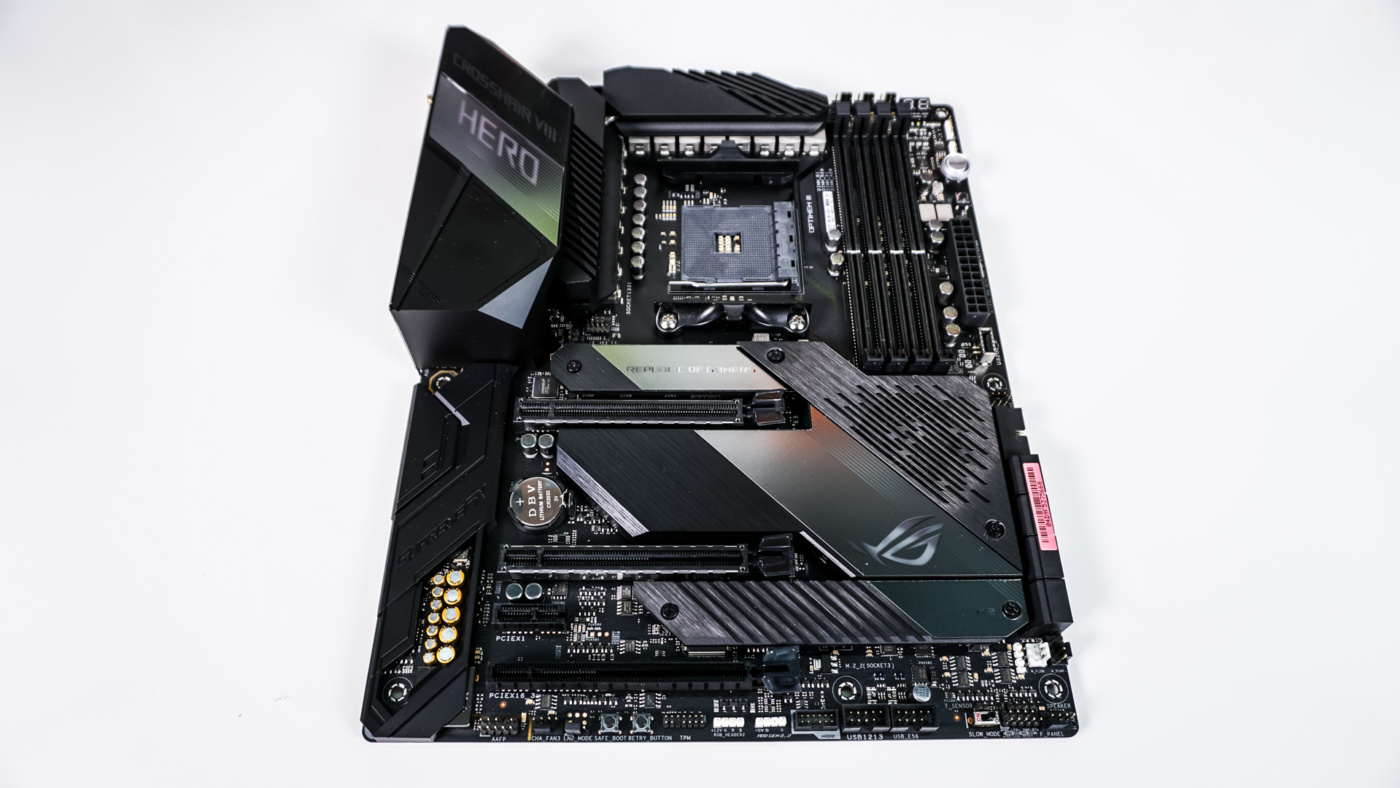ASUS ROG Crosshair VIII Hero (WiFi) Motherboard Overview
For those wondering this is a normal ATX form factor motherboard (12-inch x 9.6 inches). ASUS has gone with a matte black PCB with black accents. All of the heatsinks on the board are black, but there is a silver streak that goes across the I/O cover and heatsinks on the bottom of the board. Overall I think the board looks very sleek.
Starting at the CPU socket we of course have AMD’s AM4 socket, now X570 motherboard will support both 2nd and 3rd generation AMD Ryzen processors. Around the CPU socket we of course have the power delivery components, which are made up of IR3555 PowIRstage MOSFETs, microfine alloy chokes, and 10K Japanese-made black metallic capacitors. ASUS is making use of a 7+1 power phase design where there are two power stages for each Vcore phase. Since each power stage is 60A, each Vcore phase has 120A, so you have a total Vcore output of 840A. This means that this board is definitely made for LN2 overclocking. Another thing we noticed was the small hole in the center of the CPU socket. This is actually to mount a K Type thermocouple probe to accurately monitor temperatures. Typical sensors fail when LN2 is introduced so it is nice to have this on the board. The power delivery components are covered by two large heatsinks which are connected by a heatpipe.


At the top corner of the board you find your 8-pin EPS connector plus an extra 4-pin. The 8-pin is metal reinforced. Since ASUS has designed this board with LN2 in mind it is good to see the extra 4-pin.
Moving over to the opposite corner of the board you’ll find three 4-pin headers and a post code display. The headers are for CPU optional fan, CPU fan, and AiO pump. It is also great to see a post code display on the board.
Coming over to the memory slots there are four DDR4 DIMM slots which support memory up to 4800 MHz. These slots do not have the locks on the bottom, which makes it easier to swap out memory once you have a graphics card installed. Along the edge of the board you’ll find a 4-pin RGB header, 3-pin addressable RGB header, large power button, smaller reset button, 24-pin ATX power connection, voltage checkpoints, and a USB 3.2 gen 2 header.
Moving down the board there is a 4-pin fan header, USB 3.2 gen 1 header, eight SATA 6GB/s ports, and another 4-pin fan header.
At the bottom of the board is where you’ll find the rest of your headers and connections. From left to right you have your HD audio headers, 4-pin fan header, LN2 mode header, safe boot button, retry button, TPM header, 4-pin RGB header, 3-pin addressable RGB header, Node header, two USB 2.0 headers, slow mode switch, front panel headers, and another 4-pin fan header. The LN2 header will enable a pre-set of LN2 settings for the board. Safe boot is actually quite cool, especially if you are overclocking. Say you are overclocking, but you haven’t saved any of your settings, typically when you get to a point where you can’t boot you would have to clear your BIOS and start over. Safe boot allows you to enter the BIOS with those last used setting intact. You’ll also notice a few headers above the front panel headers there are the W_IN/OUT, W_Flow headers.
The audio components are located on the bottom left corner of the board. ASUS is making use of their SupremeFX 8-Channel high definition audio codec. This solution delivers 113dB signal-to-noise ratio on the line-in connection, a low-dropout regulator for cleaner power delivery to the SupremeFX S1220 codec, an ESS ES9023P digital-to-analog converter for superior front-panel output, as well as a Texas Instruments RC4580 op amp for high gain with low distortion. Most of the audio portion of the board is covered, but we can see the Nichicon audio capacitors.
The bottom half of the board is characterized by a large heatsink. Unlike the ASRock X570 Taichi that we reviewed recently which had a single heatsink, this section is actually three separate heatsinks, you have one of the chipset with an active cooling fan, and then one heatsink on each of the M.2 slots. The first M.2 slot sits above the top PCI-Express slot, while the second sits towards the bottom of the board between the 2nd and 3rd PCI-Express slot. The top slot supports your standard 80mm M.2 SSDs, while the bottom supports larger 110mm drives.



When it comes to expansion slots this board offers thee PCI-Express 4.0 x16 slots and a single PCI-Express 4.0 x1 slot. The first two x16 slots are metal reinforced.
The rear I/O has a very nice cover, which says “Crosshair VIII HERO” and the “HERO” part will actually light up with RGB lighting. Of course this board has an integrated I/O shield as well. When it comes to the rear I/O from left to right you have clear CMOS and BIOS flashback buttons, WiFi antennas, four USB 3.1 gen 1 ports (blue), seven USB 3.2 gen 2 ports, a USB 3.2 gen 2 Type-C port, two Ethernet ports, and your audio connections including Optical SPDIF out. For those wondering the red Ethernet port is 2.5G and powered by the Realtek RTL8125-CG controller, and the WiFi is powered by the Intel Wi-Fi 6 AX200 controller.












